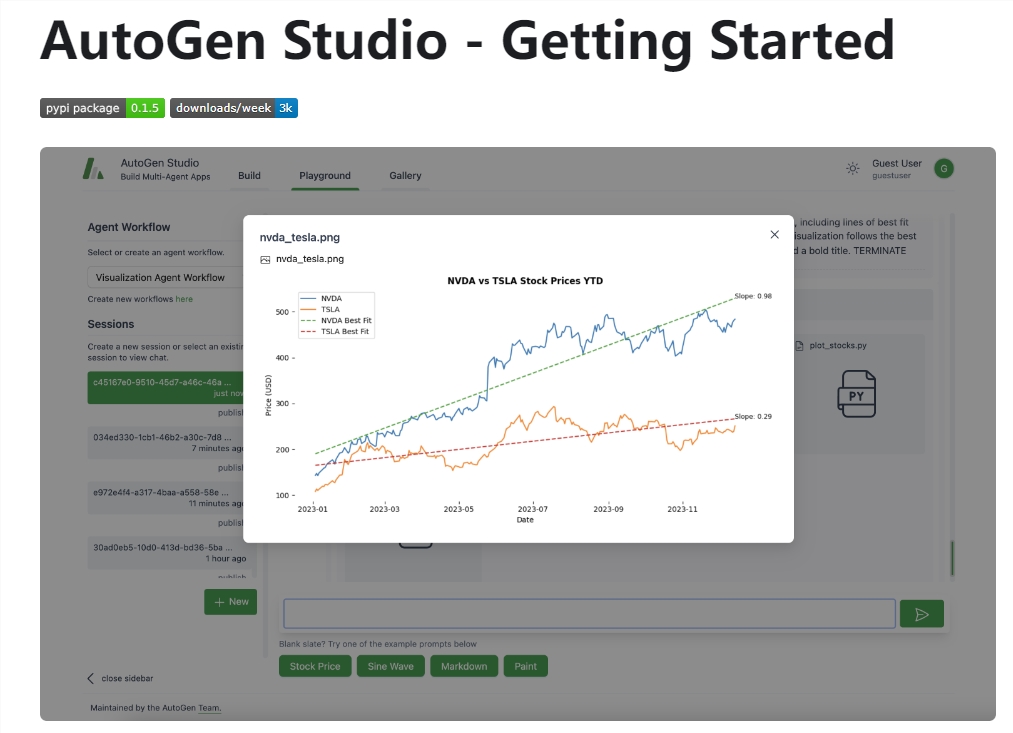AutoGen Studio, the latest low-code tool released by Microsoft Research, aims to revolutionize AI agent prototyping. The tool is based on the open source AutoGen framework, which significantly simplifies the complexity of creating and managing multi-agent workflows. AutoGen Studio provides a user-friendly interface and powerful functions, allowing developers to quickly create, enhance and combine AI agents to cope with various tasks. Whether it is a web interface or a Python API, developers can flexibly use JSON specifications to represent agents that support large language models (LLM) to meet different development needs.
Microsoft Research recently released a new low-code tool called AutoGen Studio, which aims to completely change the way developers prototype AI agents. This tool is based on the open source AutoGen framework and is designed to simplify the complex process of creating and managing multi-agent workflows. In this regard, Elvis Saravia, a machine learning and natural language processing researcher from the Distributed Artificial Intelligence Research Institute (DAIR.AI), shared the development of this technology on social media.

What is an "agent"? Analyst Jason Blumberg explains that an agent refers to autonomous software that can achieve specific business goals independently of other software around it. Although people have different opinions on its autonomy and functionality, it is undeniable that AutoGen Studio provides developers with a friendly way to develop AI agents, allowing them to quickly prototype, enhance the agent's professional skills, And combine multiple agents into complex workflows to ultimately achieve various tasks.
This tool provides both a web interface and a Python API, and developers can express agents that support large language models (LLM) through JSON specifications. This flexibility suits a variety of development preferences and skill levels. Analyst Brad Shimin said: "This is really a cool project from Microsoft. It can help enterprise developers quickly move from proof of concept to production, reducing a lot of trouble."
AutoGen Studio includes several well-designed features, such as an intuitive drag-and-drop interface for specifying agent workflows, interactive evaluation and debugging capabilities, and a library of reusable agent components. These features are built on four core design principles that Microsoft has yet to disclose in detail.
However, Microsoft also reminds everyone that AutoGen Studio is still in the development stage and may never become a mature product. "AutoGen Studio is under active development and we will iterate quickly and may introduce breaking changes in upcoming releases," Microsoft noted in a statement.
Nonetheless, the AutoGen framework already has applications in multiple industries such as advertising, customer support, network security, data analysis, education, finance, and more. This broad applicability shows the potential impact of AutoGen Studio in a variety of fields.
Blumberg added that AI agents can play an important role in an organization's cloud native strategy, and each agent can run statelessly in a container. In addition, agents based on generative AI are gradually replacing traditional robotic process automation (RPA) robots, and are replacing technologies such as business process automation and low-code/no-code platforms.
Microsoft encourages developers to use AutoGen Studio for prototyping and demonstrations, rather than as a production-ready application. For deployed applications that require authentication and advanced security, developers recommend building directly on the AutoGen framework. As AI continues to evolve and transform industries, tools like AutoGen Studio will play an important role in democratizing AI development and driving innovation in multi-agent systems.
Product entrance: https://microsoft.github.io/autogen/docs/autogen-studio/getting-started/?utm_source=the+new+stack&utm_medium=referral&utm_content=inline-mention&utm_campaign=tns+platform
All in all, AutoGen Studio, as a low-code AI agent development tool, provides developers with a convenient and efficient prototyping solution. Although it is still in the development stage, it has the potential to simplify the AI agent development process and promote multi-agent system innovation. It cannot be ignored. Its flexibility and wide applicability make it occupy an important position in future AI development.